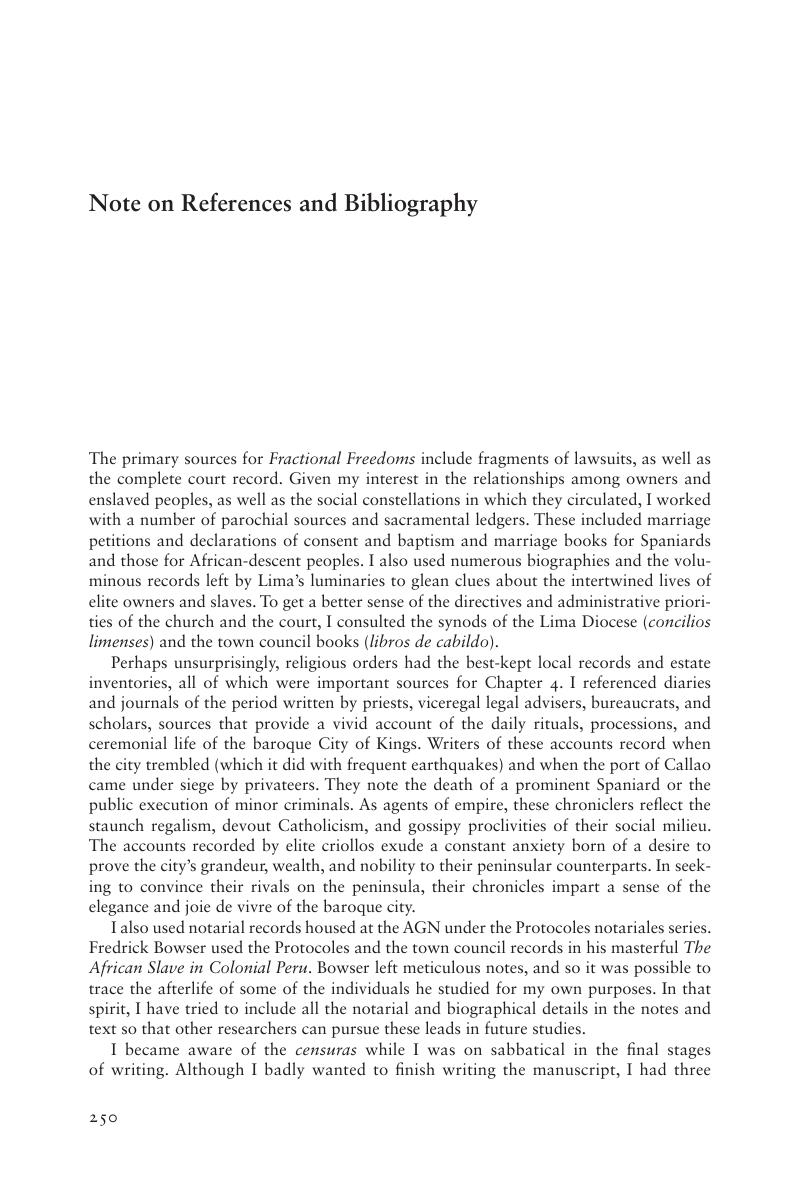Published online by Cambridge University Press: 13 October 2016

The primary sources for Fractional Freedoms include fragments of lawsuits, as well as the complete court record. Given my interest in the relationships among owners and enslaved peoples, as well as the social constellations in which they circulated, I worked with a number of parochial sources and sacramental ledgers. These included marriage petitions and declarations of consent and baptism and marriage books for Spaniards and those for African-descent peoples. I also used numerous biographies and the voluminous records left by Lima’s luminaries to glean clues about the intertwined lives of elite owners and slaves. To get a better sense of the directives and administrative priorities of the church and the court, I consulted the synods of the Lima Diocese (concilios limenses) and the town council books (libros de cabildo).
Perhaps unsurprisingly, religious orders had the best-kept local records and estate inventories, all of which were important sources for Chapter 4. I referenced diaries and journals of the period written by priests, viceregal legal advisers, bureaucrats, and scholars, sources that provide a vivid account of the daily rituals, processions, and ceremonial life of the baroque City of Kings. Writers of these accounts record when the city trembled (which it did with frequent earthquakes) and when the port of Callao came under siege by privateers. They note the death of a prominent Spaniard or the public execution of minor criminals. As agents of empire, these chroniclers reflect the staunch regalism, devout Catholicism, and gossipy proclivities of their social milieu. The accounts recorded by elite criollos exude a constant anxiety born of a desire to prove the city’s grandeur, wealth, and nobility to their peninsular counterparts. In seeking to convince their rivals on the peninsula, their chronicles impart a sense of the elegance and joie de vivre of the baroque city.
I also used notarial records housed at the AGN under the Protocoles notariales series. Fredrick Bowser used the Protocoles and the town council records in his masterful The African Slave in Colonial Peru. Bowser left meticulous notes, and so it was possible to trace the afterlife of some of the individuals he studied for my own purposes. In that spirit, I have tried to include all the notarial and biographical details in the notes and text so that other researchers can pursue these leads in future studies.
I became aware of the censuras while I was on sabbatical in the final stages of writing. Although I badly wanted to finish writing the manuscript, I had three choices: write a huge footnote that alerted readers and researchers to their existence, save the discovery for a later project, or delve into the box. I chose the third option. In the interest of time, I deliberately chose to focus on the censuras that pertained to baptismal and childhood manumission. Nonetheless, these censuras represent an untapped source that demand further study, archival cataloguing, and digital preservation.
All materials were found in Lima’s Archbishopric archive (AAL), Peru’s National archive (AGN), and the Fondo Reservado (Special Collections) at the National Library (BNP). The Franciscan archive (Archivo Franciscano) also contains critical information about rural haciendas. When possible, I consulted primary sources at the Firestone Library, the Newberry Library, and the Library of Congress in the United States.
To save this book to your Kindle, first ensure no-reply@cambridge.org is added to your Approved Personal Document E-mail List under your Personal Document Settings on the Manage Your Content and Devices page of your Amazon account. Then enter the ‘name’ part of your Kindle email address below. Find out more about saving to your Kindle.
Note you can select to save to either the @free.kindle.com or @kindle.com variations. ‘@free.kindle.com’ emails are free but can only be saved to your device when it is connected to wi-fi. ‘@kindle.com’ emails can be delivered even when you are not connected to wi-fi, but note that service fees apply.
Find out more about the Kindle Personal Document Service.
To save content items to your account, please confirm that you agree to abide by our usage policies. If this is the first time you use this feature, you will be asked to authorise Cambridge Core to connect with your account. Find out more about saving content to Dropbox.
To save content items to your account, please confirm that you agree to abide by our usage policies. If this is the first time you use this feature, you will be asked to authorise Cambridge Core to connect with your account. Find out more about saving content to Google Drive.